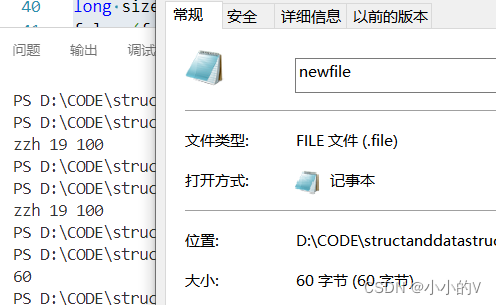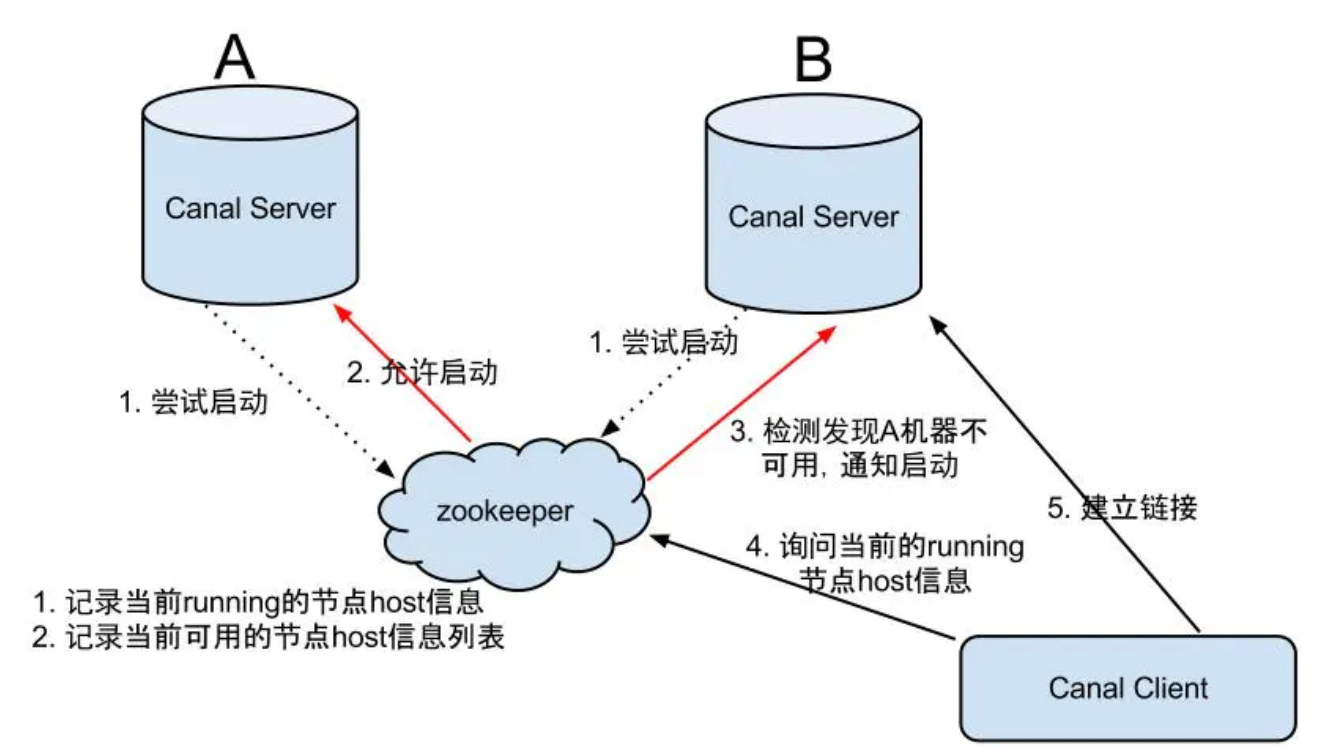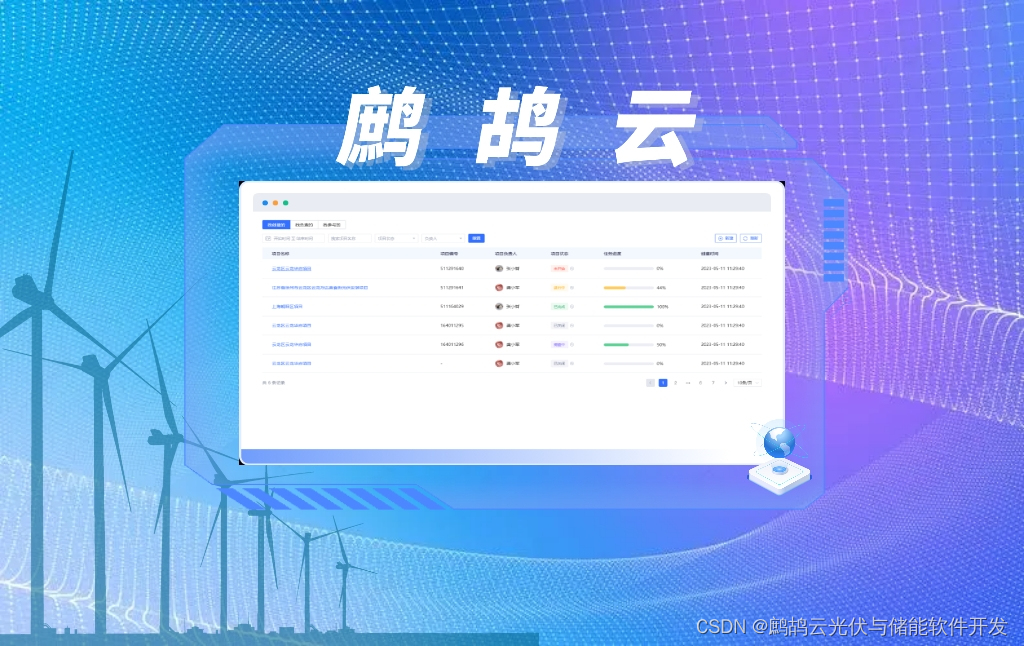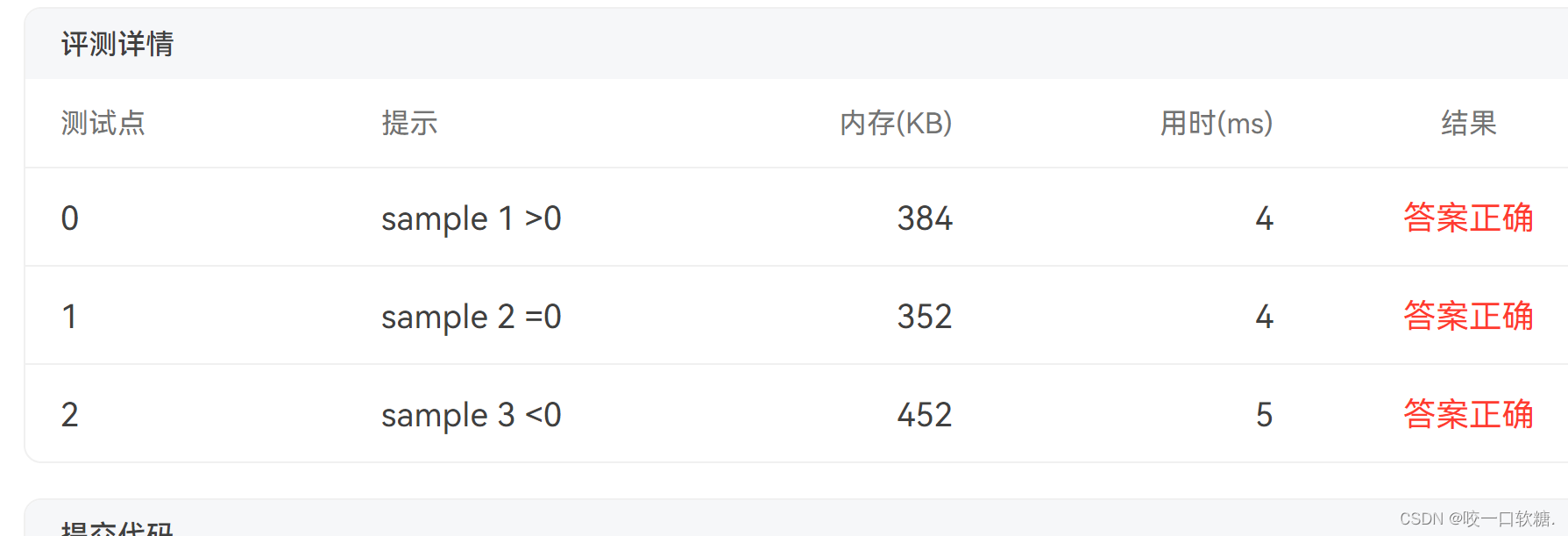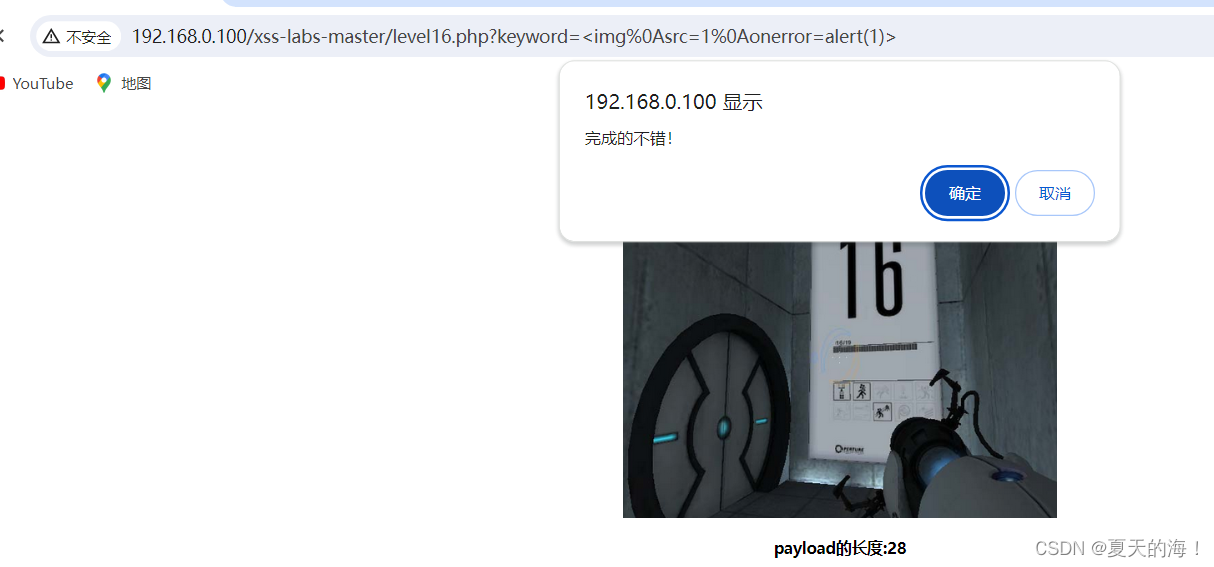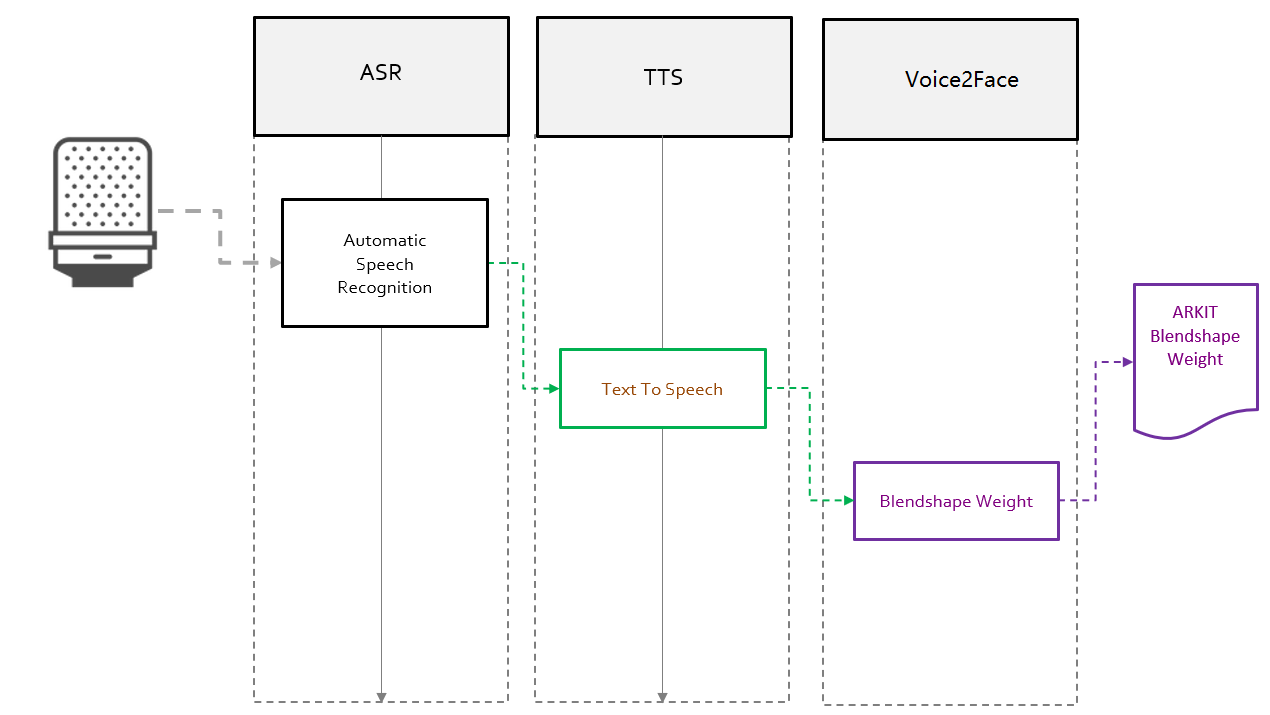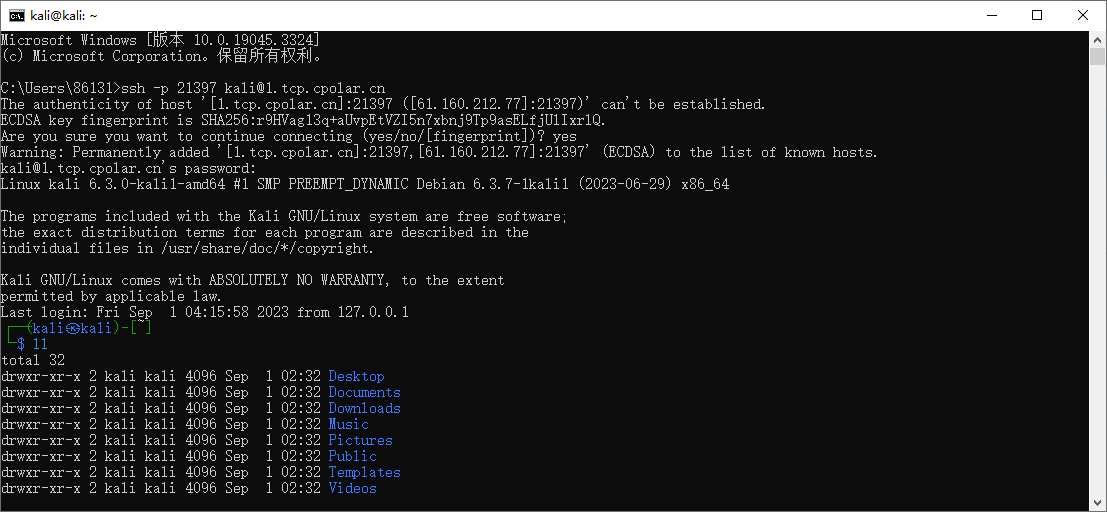pytorch深度学习项目实战100例 的学习记录
我的环境:
白票大王: google colab
用其他的话,其实实现也行,但是让小白来重环境来开始安装的话,浪费时间
论文速读
EfficientNetV2是由 Google Research,Brain Team发布在2021 ICML的一篇论文,它结合使用NAS和缩放,优化训练速度和参数效率。并且模型中使用新操作(如 Fused-MBConv)在搜索空间中进行搜索。EfficientNetV2 模型比EfficientNetV1的训练速度快得多,同时体积小 6.8 倍。
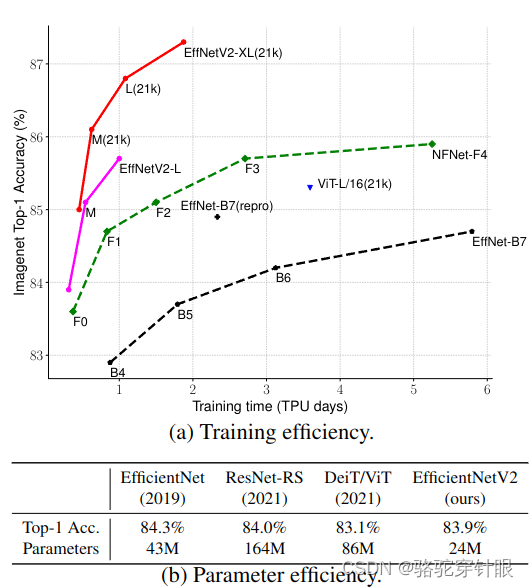
理解和提高 EfficientNetV1 的训练效率
-
使用非常大的图像尺寸进行训练很慢( Training with very large image sizes is slow)
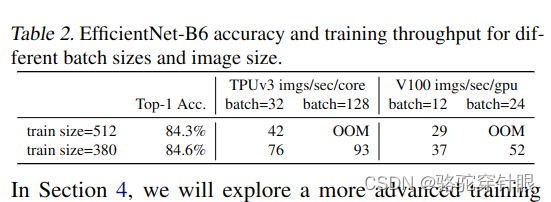
-
Depth-wise卷积在模型的早期层执行缓慢但在后期层是有效的(Depthwise convolutions are slow in early layers but effective in later stages)
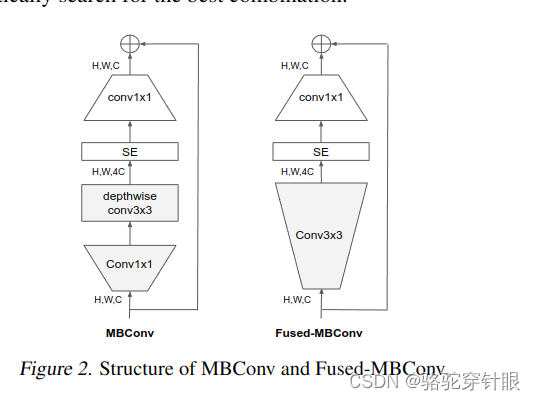
MBConv 和 Fused-MBConv 的结构
Fused-MBConv 逐渐将 EfficientNet-B4 中的原始 MBConv 替换为 Fused-MBConv。
但是不是所有替换都有效果
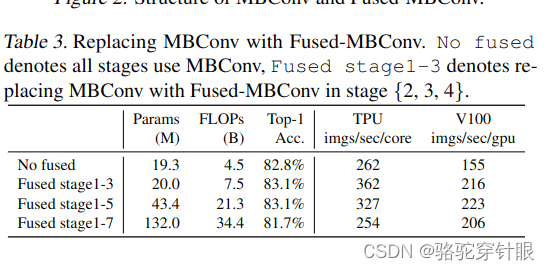
结构图
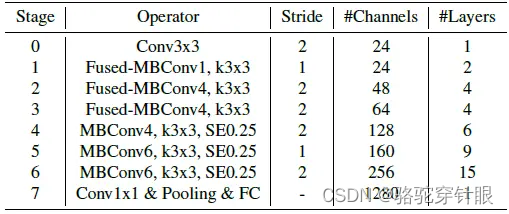
EfficientNetV2 与 EfficientNetV1有几个主要区别:
- EfficientNetV2 在早期层中广泛使用了 MBConv 和新添加的 fused-MBConv。
- EfficientNetV2 更喜欢 MBConv 的较小扩展比,因为较小的扩展比往往具有较少的内存访问开销。
- EfficientNetV2 更喜欢较小的核大小( 3×3),但它增加了更多层来补偿较小内核大小导致的感受野减少。
- EfficientNetV2 完全移除了原始 EfficientNet 中的最后一个 stride-1 阶段,这可能是由于其较大的参数大小和内存访问开销。
训练
(1) 我们将最大推理图像大小限制为 480,因为非常大的图像通常会导致昂贵的内存和训练速度开销; (2) 作为启发式,我们还逐渐将更多的层添加到后期(例如表 4 中的第 5 阶段和第 6 阶段),以增加网络容量而不会增加太多运行时开销。
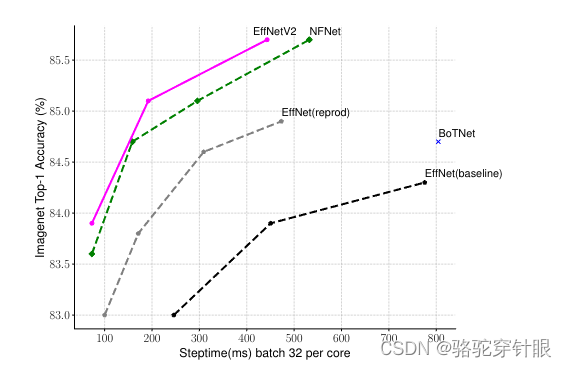
当图像尺寸较小增广较弱时模型的表现最好; 但是对于更大的图像,它在更强的增广的情况下表现更好。从小图像尺寸和弱正则化(epoch = 1)开始,然后随着更大的图像尺寸和更强的正则化逐渐增加学习难度:更大的 Dropout 率、RandAugment 幅度和混合比
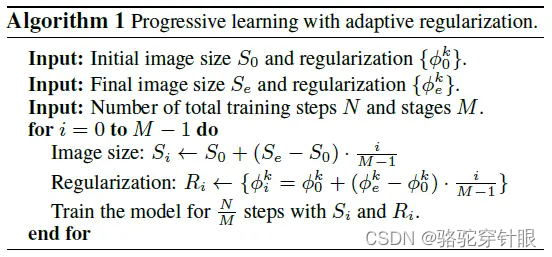
因为阿光的项目中用了mindspore,而colab上面运行不了TT
from collections import OrderedDict
from functools import partial
import mindspore.nn as nn
import mindspore.numpy as mnp
import mindspore.ops as ops
import argparse
import os
import mindspore.dataset as ds
import mindspore.dataset.transforms.c_transforms as C
import mindspore.dataset.vision.c_transforms as CV
from mindspore import Model
from mindspore import context
from mindspore import dtype as mstype
from mindspore.dataset.vision import Inter
from mindspore.nn import Accuracy
from mindspore.train.callback import LossMonitor
from mindspore.train.callback import ModelCheckpoint, CheckpointConfig
def drop_path(x, drop_prob: float = 0., training: bool = False):
if drop_prob == 0. or not training:
return x
keep_prob = 1 - drop_prob
shape = (x.shape[0],) + (1,) * (x.ndim - 1) # work with diff dim tensors, not just 2D ConvNets
# random_tensor = keep_prob + Tensor(torch.rand(shape).numpy())
stdnormal = ops.StandardNormal(seed=1)
random_tensor = keep_prob + stdnormal(shape)
# random_tensor.floor_() # binarize
random_tensor = mnp.floor(random_tensor)
output = mnp.divide(x, keep_prob) * random_tensor
# output = x.div(keep_prob) * random_tensor
return output
class DropPath(nn.Cell):
def __init__(self, drop_prob=None):
super(DropPath, self).__init__()
self.drop_prob = drop_prob
def construct(self, x):
return drop_path(x, self.drop_prob, self.training)
class ConvBNAct(nn.Cell):
def __init__(self,
in_planes: int,
out_planes: int,
kernel_size: int = 3,
stride: int = 1,
groups: int = 1,
norm_layer=None,
activation_layer=None):
super(ConvBNAct, self).__init__()
# self.activation=activation_layer
padding = (kernel_size - 1) // 2
if norm_layer is None:
norm_layer = nn.BatchNorm2d
if activation_layer is None:
activation_layer = nn.ReLU # alias Swish (torch>=1.7)
self.conv = nn.Conv2d(in_channels=in_planes,
out_channels=out_planes,
kernel_size=kernel_size,
stride=stride,
# padding=padding,
group=groups,
has_bias=False)
self.bn = norm_layer(out_planes)
# if self.activation is not no':
self.act = activation_layer()
def construct(self, x):
result = self.conv(x)
result = self.bn(result)
# if self.activation is not 'no':
result = self.act(result)
return result
class SqueezeExcite(nn.Cell):
def __init__(self,
input_c: int, # block input channel
expand_c: int, # block expand channel
se_ratio: float = 0.25):
super(SqueezeExcite, self).__init__()
squeeze_c = int(input_c * se_ratio)
self.conv_reduce = nn.Conv2d(expand_c, squeeze_c, 1, pad_mode='valid')
self.act1 = nn.ReLU() # alias Swish
self.conv_expand = nn.Conv2d(squeeze_c, expand_c, 1, pad_mode='valid')
self.act2 = nn.Sigmoid()
def construct(self, x):
scale = x.mean((2, 3), keep_dims=True)
scale = self.conv_reduce(scale)
scale = self.act1(scale)
scale = self.conv_expand(scale)
scale = self.act2(scale)
return scale * x
class MBConv(nn.Cell):
def __init__(self,
kernel_size: int,
input_c: int,
out_c: int,
expand_ratio: int,
stride: int,
se_ratio: float,
drop_rate: float,
norm_layer):
super(MBConv, self).__init__()
if stride not in [1, 2]:
raise ValueError("illegal stride value.")
self.has_shortcut = (stride == 1 and input_c == out_c)
activation_layer = nn.ReLU # alias Swish
expanded_c = input_c * expand_ratio
# 在EfficientNetV2中,MBConv中不存在expansion=1的情况所以conv_pw肯定存在
assert expand_ratio != 1
# Point-wise expansion
self.expand_conv = ConvBNAct(input_c,
expanded_c,
kernel_size=1,
norm_layer=norm_layer,
activation_layer=activation_layer)
# Depth-wise convolution
self.dwconv = ConvBNAct(expanded_c,
expanded_c,
kernel_size=kernel_size,
stride=stride,
groups=expanded_c,
norm_layer=norm_layer,
activation_layer=activation_layer)
# self.se = SqueezeExcite(input_c, expanded_c, se_ratio) if se_ratio > 0 else ops.Identity
self.se = SqueezeExcite(input_c, expanded_c, se_ratio) if se_ratio > 0 else None
# Point-wise linear projection
self.project_conv = ConvBNAct(expanded_c,
out_planes=out_c,
kernel_size=1,
norm_layer=norm_layer,
# activation_layer=ops.Identity
) # 注意这里没有激活函数,所有传入Identity
self.out_channels = out_c
# 只有在使用shortcut连接时才使用dropout层
self.drop_rate = drop_rate
if self.has_shortcut and drop_rate > 0:
self.dropout = DropPath(drop_rate)
def construct(self, x):
result = self.expand_conv(x)
result = self.dwconv(result)
# if self.se != 'no':
if self.se is not None:
result = self.se(result)
result = self.project_conv(result)
if self.has_shortcut:
if self.drop_rate > 0:
result = self.dropout(result)
result += x
return result
class FusedMBConv(nn.Cell):
def __init__(self,
kernel_size: int,
input_c: int,
out_c: int,
expand_ratio: int,
stride: int,
se_ratio: float,
drop_rate: float,
norm_layer):
super(FusedMBConv, self).__init__()
assert stride in [1, 2]
assert se_ratio == 0
self.has_shortcut = stride == 1 and input_c == out_c
self.drop_rate = drop_rate
self.has_expansion = expand_ratio != 1
activation_layer = nn.ReLU # alias Swish
expanded_c = input_c * expand_ratio
# 只有当expand ratio不等于1时才有expand conv
if self.has_expansion:
# Expansion convolution
self.expand_conv = ConvBNAct(input_c,
expanded_c,
kernel_size=kernel_size,
stride=stride,
norm_layer=norm_layer,
activation_layer=activation_layer)
self.project_conv = ConvBNAct(expanded_c,
out_c,
kernel_size=1,
norm_layer=norm_layer,
# activation_layer=ops.Identity
) # 注意没有激活函数
else:
# 当只有project_conv时的情况
self.project_conv = ConvBNAct(input_c,
out_c,
kernel_size=kernel_size,
stride=stride,
norm_layer=norm_layer,
activation_layer=activation_layer) # 注意有激活函数
self.out_channels = out_c
# 只有在使用shortcut连接时才使用dropout层
self.drop_rate = drop_rate
if self.has_shortcut and drop_rate > 0:
self.dropout = DropPath(drop_rate)
def construct(self, x):
if self.has_expansion:
result = self.expand_conv(x)
result = self.project_conv(result)
else:
result = self.project_conv(x)
if self.has_shortcut:
if self.drop_rate > 0:
result = self.dropout(result)
result += x
return result
class EfficientNetV2(nn.Cell):
def __init__(self,
model_cnf: list,
num_classes: int = 10,
num_features: int = 128,
dropout_rate: float = 0.2,
drop_connect_rate: float = 0.2):
super(EfficientNetV2, self).__init__()
for cnf in model_cnf:
assert len(cnf) == 8
norm_layer = partial(nn.BatchNorm2d, eps=1e-3, momentum=0.1)
stem_filter_num = model_cnf[0][4]
self.stem = ConvBNAct(1,
stem_filter_num,
kernel_size=3,
stride=2,
norm_layer=norm_layer) # 激活函数默认是SiLU
total_blocks = sum([i[0] for i in model_cnf])
block_id = 0
blocks = []
for cnf in model_cnf:
repeats = cnf[0]
op = FusedMBConv if cnf[-2] == 0 else MBConv
for i in range(repeats):
blocks.append(op(kernel_size=cnf[1],
input_c=cnf[4] if i == 0 else cnf[5],
out_c=cnf[5],
expand_ratio=cnf[3],
stride=cnf[2] if i == 0 else 1,
se_ratio=cnf[-1],
drop_rate=drop_connect_rate * block_id / total_blocks,
norm_layer=norm_layer))
block_id += 1
self.blocks = nn.SequentialCell(*blocks)
head_input_c = model_cnf[-1][-3]
head = OrderedDict()
head.update({"project_conv": ConvBNAct(head_input_c,
num_features,
kernel_size=1,
norm_layer=norm_layer)}) # 激活函数默认是SiLU
# self.adaptive=ops.AdaptiveAvgPool2D((None,1))
# head.update({"avgpool": ops.AdaptiveAvgPool2D(None,1)})
head.update({"flatten": nn.Flatten()})
if dropout_rate > 0:
head.update({"dropout": nn.Dropout(keep_prob=dropout_rate)})
head.update({"classifier": nn.Dense(num_features, num_classes)})
self.head = nn.SequentialCell(head)
self.avgpool = nn.AvgPool2d(kernel_size=(10, 12), pad_mode='valid')
def construct(self, x):
x = self.stem(x)
x = self.blocks(x)
x = self.avgpool(x)
# x = self.adaptive(x)
x = self.head(x)
return x
def efficientnetv2_s(num_classes: int = 10):
model_config = [[2, 3, 1, 1, 24, 24, 0, 0],
[4, 3, 2, 4, 24, 48, 0, 0],
[4, 3, 2, 4, 48, 64, 0, 0],
[6, 3, 2, 4, 64, 128, 1, 0.25],
[9, 3, 1, 6, 128, 160, 1, 0.25],
[15, 3, 2, 6, 160, 256, 1, 0.25]]
model = EfficientNetV2(model_cnf=model_config,
num_classes=num_classes,
dropout_rate=0.2)
return model
def create_dataset(data_path, batch_size=32, repeat_size=1,
num_parallel_workers=1):
# 定义数据集
mnist_ds = ds.MnistDataset(data_path)
resize_height, resize_width = 300, 384
# 定义所需要操作的map映射
resize_op = CV.Resize((resize_height, resize_width), interpolation=Inter.LINEAR)
hwc2chw_op = CV.HWC2CHW()
type_cast_op = C.TypeCast(mstype.int32)
type_cast_op_image = C.TypeCast(mstype.float32)
# 使用map映射函数,将数据操作应用到数据集
mnist_ds = mnist_ds.map(operations=type_cast_op, input_columns="label", num_parallel_workers=num_parallel_workers)
mnist_ds = mnist_ds.map(operations=type_cast_op_image, input_columns="image",
num_parallel_workers=num_parallel_workers)
mnist_ds = mnist_ds.map(operations=resize_op, input_columns="image", num_parallel_workers=num_parallel_workers)
mnist_ds = mnist_ds.map(operations=hwc2chw_op, input_columns="image", num_parallel_workers=num_parallel_workers)
# 进行shuffle、batch操作
buffer_size = 1000
mnist_ds = mnist_ds.shuffle(buffer_size=buffer_size)
mnist_ds = mnist_ds.batch(batch_size, drop_remainder=True)
return mnist_ds
def train_net(args, model, batch_size, epoch_size, data_path, repeat_size, ckpoint_cb, sink_mode):
ds_train = create_dataset(os.path.join(data_path, 'train'), batch_size, repeat_size)
model.train(epoch_size, ds_train, callbacks=[ckpoint_cb, LossMonitor(10)], dataset_sink_mode=sink_mode)
def test_net(network, model, data_path):
ds_eval = create_dataset(os.path.join(data_path, 'test'))
acc = model.eval(ds_eval, dataset_sink_mode=False)
print('{}'.format(acc))
net = efficientnetv2_s(num_classes=10)
parser = argparse.ArgumentParser(description='MindSpore Example')
parser.add_argument('--device_target', type=str, default="CPU", choices=['Ascend', 'GPU', 'CPU'])
args = parser.parse_known_args()[0]
context.set_context(mode=context.GRAPH_MODE, device_target=args.device_target)
# 定义损失函数
net_loss = nn.SoftmaxCrossEntropyWithLogits(sparse=True, reduction='mean')
# 定义优化器
net_opt = nn.Momentum(net.trainable_params(), learning_rate=0.01, momentum=0.9)
# 设置模型保存参数
config_ck = CheckpointConfig(save_checkpoint_steps=1875, keep_checkpoint_max=10)
# 应用模型保存参数
ckpoint = ModelCheckpoint(prefix='checkpoint_efficientvs', config=config_ck)
train_epoch = 10
# mnist_path = './datasets/cifar-10-batches-bin'
mnist_path = './datasets/MNIST_Data'
dataset_size = 1
batch_size = 16
model = Model(net, net_loss, net_opt, metrics={"Accuracy": Accuracy()})
train_net(args, model, batch_size, train_epoch, mnist_path, dataset_size, ckpoint, False)
test_net(net, model, mnist_path)
自己重新写了pytorch的版本,来重新训练
网路结构
import copy
from functools import partial
from collections import OrderedDict
import torch
from torch import nn
def get_efficientnet_v2_structure(model_name):
if 'efficientnet_v2_s' in model_name:
return [
# e k s in out xN se fused
(1, 3, 1, 24, 24, 2, False, True),
(4, 3, 2, 24, 48, 4, False, True),
(4, 3, 2, 48, 64, 4, False, True),
(4, 3, 2, 64, 128, 6, True, False),
(6, 3, 1, 128, 160, 9, True, False),
(6, 3, 2, 160, 256, 15, True, False),
]
elif 'efficientnet_v2_m' in model_name:
return [
# e k s in out xN se fused
(1, 3, 1, 24, 24, 3, False, True),
(4, 3, 2, 24, 48, 5, False, True),
(4, 3, 2, 48, 80, 5, False, True),
(4, 3, 2, 80, 160, 7, True, False),
(6, 3, 1, 160, 176, 14, True, False),
(6, 3, 2, 176, 304, 18, True, False),
(6, 3, 1, 304, 512, 5, True, False),
]
elif 'efficientnet_v2_l' in model_name:
return [
# e k s in out xN se fused
(1, 3, 1, 32, 32, 4, False, True),
(4, 3, 2, 32, 64, 7, False, True),
(4, 3, 2, 64, 96, 7, False, True),
(4, 3, 2, 96, 192, 10, True, False),
(6, 3, 1, 192, 224, 19, True, False),
(6, 3, 2, 224, 384, 25, True, False),
(6, 3, 1, 384, 640, 7, True, False),
]
elif 'efficientnet_v2_xl' in model_name:
return [
# e k s in out xN se fused
(1, 3, 1, 32, 32, 4, False, True),
(4, 3, 2, 32, 64, 8, False, True),
(4, 3, 2, 64, 96, 8, False, True),
(4, 3, 2, 96, 192, 16, True, False),
(6, 3, 1, 192, 256, 24, True, False),
(6, 3, 2, 256, 512, 32, True, False),
(6, 3, 1, 512, 640, 8, True, False),
]
class ConvBNAct(nn.Sequential):
"""Convolution-Normalization-Activation Module"""
def __init__(self, in_channel, out_channel, kernel_size, stride, groups, norm_layer, act, conv_layer=nn.Conv2d):
super(ConvBNAct, self).__init__(
conv_layer(in_channel, out_channel, kernel_size, stride=stride, padding=(kernel_size-1)//2, groups=groups, bias=False),
norm_layer(out_channel),
act()
)
class SEUnit(nn.Module):
"""Squeeze-Excitation Unit
paper: https://openaccess.thecvf.com/content_cvpr_2018/html/Hu_Squeeze-and-Excitation_Networks_CVPR_2018_paper
"""
def __init__(self, in_channel, reduction_ratio=4, act1=partial(nn.SiLU, inplace=True), act2=nn.Sigmoid):
super(SEUnit, self).__init__()
hidden_dim = in_channel // reduction_ratio
self.avg_pool = nn.AdaptiveAvgPool2d((1, 1))
self.fc1 = nn.Conv2d(in_channel, hidden_dim, (1, 1), bias=True)
self.fc2 = nn.Conv2d(hidden_dim, in_channel, (1, 1), bias=True)
self.act1 = act1()
self.act2 = act2()
def forward(self, x):
return x * self.act2(self.fc2(self.act1(self.fc1(self.avg_pool(x)))))
class StochasticDepth(nn.Module):
"""StochasticDepth
paper: https://link.springer.com/chapter/10.1007/978-3-319-46493-0_39
:arg
- prob: Probability of dying
- mode: "row" or "all". "row" means that each row survives with different probability
"""
def __init__(self, prob, mode):
super(StochasticDepth, self).__init__()
self.prob = prob
self.survival = 1.0 - prob
self.mode = mode
def forward(self, x):
if self.prob == 0.0 or not self.training:
return x
else:
shape = [x.size(0)] + [1] * (x.ndim - 1) if self.mode == 'row' else [1]
return x * torch.empty(shape).bernoulli_(self.survival).div_(self.survival).to(x.device)
class MBConvConfig:
"""EfficientNet Building block configuration"""
def __init__(self, expand_ratio: float, kernel: int, stride: int, in_ch: int, out_ch: int, layers: int,
use_se: bool, fused: bool, act=nn.SiLU, norm_layer=nn.BatchNorm2d):
self.expand_ratio = expand_ratio
self.kernel = kernel
self.stride = stride
self.in_ch = in_ch
self.out_ch = out_ch
self.num_layers = layers
self.act = act
self.norm_layer = norm_layer
self.use_se = use_se
self.fused = fused
@staticmethod
def adjust_channels(channel, factor, divisible=8):
new_channel = channel * factor
divisible_channel = max(divisible, (int(new_channel + divisible / 2) // divisible) * divisible)
divisible_channel += divisible if divisible_channel < 0.9 * new_channel else 0
return divisible_channel
class MBConv(nn.Module):
"""EfficientNet main building blocks
:arg
- c: MBConvConfig instance
- sd_prob: stochastic path probability
"""
def __init__(self, c, sd_prob=0.0):
super(MBConv, self).__init__()
inter_channel = c.adjust_channels(c.in_ch, c.expand_ratio)
block = []
if c.expand_ratio == 1:
block.append(('fused', ConvBNAct(c.in_ch, inter_channel, c.kernel, c.stride, 1, c.norm_layer, c.act)))
elif c.fused:
block.append(('fused', ConvBNAct(c.in_ch, inter_channel, c.kernel, c.stride, 1, c.norm_layer, c.act)))
block.append(('fused_point_wise', ConvBNAct(inter_channel, c.out_ch, 1, 1, 1, c.norm_layer, nn.Identity)))
else:
block.append(('linear_bottleneck', ConvBNAct(c.in_ch, inter_channel, 1, 1, 1, c.norm_layer, c.act)))
block.append(('depth_wise', ConvBNAct(inter_channel, inter_channel, c.kernel, c.stride, inter_channel, c.norm_layer, c.act)))
block.append(('se', SEUnit(inter_channel, 4 * c.expand_ratio)))
block.append(('point_wise', ConvBNAct(inter_channel, c.out_ch, 1, 1, 1, c.norm_layer, nn.Identity)))
self.block = nn.Sequential(OrderedDict(block))
self.use_skip_connection = c.stride == 1 and c.in_ch == c.out_ch
self.stochastic_path = StochasticDepth(sd_prob, "row")
def forward(self, x):
out = self.block(x)
if self.use_skip_connection:
out = x + self.stochastic_path(out)
return out
class EfficientNetV2(nn.Module):
"""Pytorch Implementation of EfficientNetV2
paper: https://arxiv.org/abs/2104.00298
- reference 1 (pytorch): https://github.com/d-li14/efficientnetv2.pytorch/blob/main/effnetv2.py
- reference 2 (official): https://github.com/google/automl/blob/master/efficientnetv2/effnetv2_configs.py
:arg
- layer_infos: list of MBConvConfig
- out_channels: bottleneck channel
- nlcass: number of class
- dropout: dropout probability before classifier layer
- stochastic depth: stochastic depth probability
"""
def __init__(self, layer_infos, out_channels=1280, nclass=0, dropout=0.2, stochastic_depth=0.0,
block=MBConv, act_layer=nn.SiLU, norm_layer=nn.BatchNorm2d):
super(EfficientNetV2, self).__init__()
self.layer_infos = layer_infos
self.norm_layer = norm_layer
self.act = act_layer
self.in_channel = layer_infos[0].in_ch
self.final_stage_channel = layer_infos[-1].out_ch
self.out_channels = out_channels
self.cur_block = 0
self.num_block = sum(stage.num_layers for stage in layer_infos)
self.stochastic_depth = stochastic_depth
self.stem = ConvBNAct(3, self.in_channel, 3, 2, 1, self.norm_layer, self.act)
self.blocks = nn.Sequential(*self.make_stages(layer_infos, block))
self.head = nn.Sequential(OrderedDict([
('bottleneck', ConvBNAct(self.final_stage_channel, out_channels, 1, 1, 1, self.norm_layer, self.act)),
('avgpool', nn.AdaptiveAvgPool2d((1, 1))),
('flatten', nn.Flatten()),
('dropout', nn.Dropout(p=dropout, inplace=True)),
('classifier', nn.Linear(out_channels, nclass) if nclass else nn.Identity())
]))
def make_stages(self, layer_infos, block):
return [layer for layer_info in layer_infos for layer in self.make_layers(copy.copy(layer_info), block)]
def make_layers(self, layer_info, block):
layers = []
for i in range(layer_info.num_layers):
layers.append(block(layer_info, sd_prob=self.get_sd_prob()))
layer_info.in_ch = layer_info.out_ch
layer_info.stride = 1
return layers
def get_sd_prob(self):
sd_prob = self.stochastic_depth * (self.cur_block / self.num_block)
self.cur_block += 1
return sd_prob
def forward(self, x):
return self.head(self.blocks(self.stem(x)))
def change_dropout_rate(self, p):
self.head[-2] = nn.Dropout(p=p, inplace=True)
def efficientnet_v2_init(model):
for m in model.modules():
if isinstance(m, nn.Conv2d):
nn.init.kaiming_normal_(m.weight, mode='fan_out')
if m.bias is not None:
nn.init.zeros_(m.bias)
elif isinstance(m, (nn.BatchNorm2d, nn.GroupNorm)):
nn.init.ones_(m.weight)
nn.init.zeros_(m.bias)
elif isinstance(m, nn.Linear):
nn.init.normal_(m.weight, mean=0.0, std=0.01)
nn.init.zeros_(m.bias)
def get_efficientnet_v2(model_name, pretrained, nclass=0, dropout=0.1, stochastic_depth=0.2, **kwargs):
residual_config = [MBConvConfig(*layer_config) for layer_config in get_efficientnet_v2_structure(model_name)]
model = EfficientNetV2(residual_config, 1280, nclass, dropout=dropout, stochastic_depth=stochastic_depth, block=MBConv, act_layer=nn.SiLU)
efficientnet_v2_init(model)
return model
调用EfficientNet_V2_S的结构
# 获取EfficientNet V2 S的结构配置
model_name = 'efficientnet_v2_s'
pretrained = False # Assuming custom implementation without pretrained weights
nclass = 10 # For MNIST
dropout = 0.1
stochastic_depth = 0.2
model = get_efficientnet_v2(model_name, pretrained, nclass, dropout, stochastic_depth)
调用torchvision 的MNIST数据集
import torchvision
import torchvision.transforms as transforms
from torch.utils.data import DataLoader
transform = transforms.Compose([
transforms.Resize((224, 224)), # Resize to match EfficientNet's expected input
transforms.Grayscale(num_output_channels=3), # Convert to 3-channel RGB
transforms.ToTensor(),
transforms.Normalize((0.5, 0.5, 0.5), (0.5, 0.5, 0.5)) # Normalize for 3 channels
])
train_dataset = torchvision.datasets.MNIST(root='./data', train=True, download=True, transform=transform)
train_loader = DataLoader(train_dataset, batch_size=32, shuffle=True)
test_dataset = torchvision.datasets.MNIST(root='./data', train=False, download=True, transform=transform)
test_loader = DataLoader(test_dataset, batch_size=32, shuffle=False)
训练和优化器
device = torch.device("cuda" if torch.cuda.is_available() else "cpu")
model.to(device)
optimizer = torch.optim.Adam(model.parameters(), lr=0.001)
criterion = torch.nn.CrossEntropyLoss()
epochs =100
# Training loop
model.train()
for epoch in range(epochs):
for images, labels in train_loader:
images, labels = images.to(device), labels.to(device)
optimizer.zero_grad()
outputs = model(images)
loss = criterion(outputs, labels)
loss.backward()
optimizer.step()
print(f"Epoch {epoch+1}, Loss: {loss.item()}")
测试
def test(model, device, test_loader, criterion):
model.eval() # Set the model to evaluation mode
test_loss = 0
correct = 0
with torch.no_grad(): # No need to track gradients for validation
for images, labels in test_loader:
images, labels = images.to(device), labels.to(device)
outputs = model(images)
test_loss += criterion(outputs, labels).item() # Sum up batch loss
pred = outputs.argmax(dim=1, keepdim=True) # Get the index
代码审批过后上传,记得点赞和收藏
